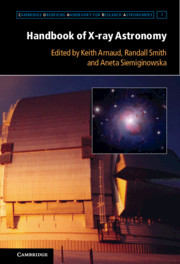8 - Extended emission
Published online by Cambridge University Press: 05 June 2012
Summary
Introduction
This chapter describes X-ray data reduction for extended sources; the process required to isolate an image of the source from the background or to isolate the source spectrum from all of its backgrounds. We begin by describing the ways in which data are less than ideal and what general methods are employed to work around these problems. We then walk through a typical reduction, posing and discussing the questions that need to be considered with each step.
Study of diffuse sources is usually done with imaging spectrometers such as position-sensitive proportional counters and CCDs. Combining spectral and imaging (photometric) data increases the versatility of the analysis, but that versatility comes at the price of more complex procedures, which require simultaneous analysis of both the spectra and the photometry.
A brief consideration of photometry demonstrates why this is the case for non-ideal detectors. First, a region is defined that includes the source and a second “background” region that is free of sources. For an ideal detector, the surface brightness in the background region (in counts/pixel) can simply be determined and subtracted from the source region. Several modifications are required for non-ideal detectors where the response and the point spread function (PSF) may vary with position.
- Type
- Chapter
- Information
- Handbook of X-ray Astronomy , pp. 146 - 162Publisher: Cambridge University PressPrint publication year: 2011

